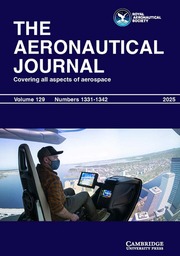No CrossRef data available.
Article contents
Numerical investigation of magnetic pole angle on the aerodynamic heating and force properties of hypersonic magnetohydrodynamic in two-dimensional axisymmetric geometry
Published online by Cambridge University Press: 14 July 2025
Abstract
The hypersonic vehicle surfaces are subjected to intense thermal loads during atmospheric re-entry. Such conditions induce material ablation and structural deformation, potentially causing changes to aerodynamic configuration that critically endanger mission integrity. In this paper, a mathematical model of thermochemical non-equilibrium magnetohydrodynamics (MHD) at low magnetic Reynolds number is introduced to investigate the effects of MHD on the flow field. Variation of the magnetic pole angle (θ), the flow field profiles are quantitatively analysed, including gas component distributions and aerodynamic heating characteristics. Results indicate that the heat flux at the stagnation point initially decreases and then increases with θ increasing, reaching a minimum at θ = 60°. A portion of the heat flux from the blunt position is transferred to the shoulder (α between 30° and 60°). Notably, the shock standoff distance also shows a non-monotonic trend with θ increasing, peaking at θ = 30°, mirroring the effect of θ on the stagnation point heat flux. As θ increases, the component of the Lorentz force along the X-direction gradually increases, with its peak position corresponding to the shock standoff distance. The electrons and nitrogen atoms are primarily concentrated at the blunt nose, while nitric oxide and oxygen atoms are predominantly distributed along the vehicle wall. The dissociation region of the gas is influenced by the shock standoff distance, which increases as the shock standoff distance increases. At θ = 30°, the concentration of oxygen atoms, nitrogen atoms, nitric oxide molecules and electrons on the stagnation point line reaches its maximum. The present study provides a theoretical foundation for the application of MHD thermal protection methods on hypersonic vehicles.
Keywords
Information
- Type
- Research Article
- Information
- Copyright
- © The Author(s), 2025. Published by Cambridge University Press on behalf of Royal Aeronautical Society
Footnotes
First author: Weifeng Gao


